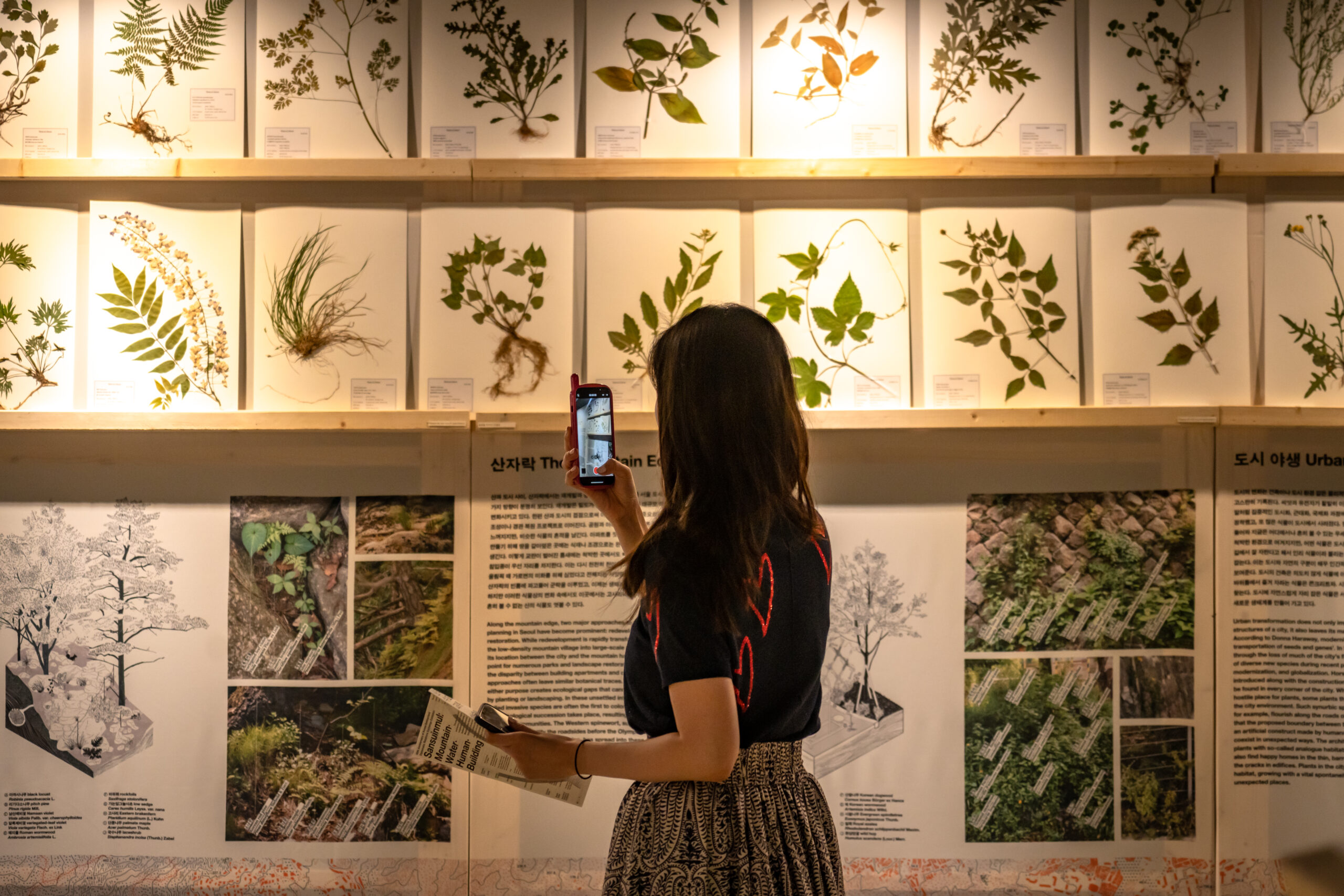장소 서울도시건축전시관
일시 2023. 6. 13 – 8. 13
총괄기획 남성택
전시기획 김남주, 지강일, 프레드 찬도 김
주최 서울특별시 주택정책식 특별기획과 / 주한 스위스 대사관
주관 서울도시건축전시관
전시 참여 김남주, 제랄딘 보리오, 안수정, 프레드 찬도 김
Venue Seoul Hall of Architecture and Urbanism
Date Jun 13 – Aug 13, 2023
Chief Curator Sung-Taeg Nam
Curator Namjoo Kim, Kangil Ji, Fred Chando Kim
Host Seoul Metropolitan Government / Embassy of Switzerland in the Republic of Korea
Organizer Seoul Hall of Architecture and Urbanism
With Namjoo Kim, Geraldin Borio, Susann Ahn, and Fred Chando Kim

(English below)
산의 도시, 식물의 도시
식물을 방법으로 서울 읽기
‘도시는 인간과 자연, 실제와 허구, 기계와 유기적인 것이 엮여 있는 과정의 네트워크이다…. 도시에서 사회와 자연, 표현과 실제는 분리될 수 없고, 서로에게 필수적이며, 무한히 얽혀 있다.’
에릭 스윈기도우, ‘하이브리드로서의 도시’ (1996)
식물은 도시에 대해 무엇을 말해 줄 수 있을까? 우리가 물리적 구조와 건축, 혹은 사회적 현상으로 도시를 분석하듯이, 식물은 도시를 읽는 새로운 방법을 알려준다. 북한산의 가장 높은 백운대에서부터 번화한 도심, 그리고 한강 변에 이르기까지 서울에는 다양한 식물이 자라고 있다. 이러한 식물은 도시와 산, 사람과 자연이 분리된 것이 아니라 언제나 흐름과 상호작용 속에 있다는 것을 말해준다. 북한산에 흔한 리기다소나무와 아까시나무는 벌채로 인해 민둥산이 된 산을 녹화하려는 적극적인 식재의 결과이다. 산이 단지 순수한 자연의 영역이 아니라 적극적으로 개입하여 관리하고 이용해 온 사람의 영토이기도 하다는 것을 보여준다. 한편 서울 어디라도 길가와 틈새에 저절로 무성하게 자라나는 질경이와 명아주 같은 자생식물은 도시에도 건재하는 야생을 드러낸다. 식물의 관점에서 보면, 산과 도시, 자연과 인공, 인간과 비인간 존재는 서로 분리할 수 없는 복잡한 네트워크를 이루고 있다. 그러니 산이라는 지형적, 생태적 조건과 그 안의 다양한 동물과 식물은 사람과 함께 서울 구석구석에서 도시의 역사, 문화, 건축과 공간을 만들어 온 협력자이기도 하다. 사람 활동의 흔적이 지층에 남는다는 인류세의 시대, 사람의 영향이 도시의 경계에 국한되지 않는다는 행성적 도시화의 논의 속에 우리는 저 밖이 아닌 우리 곁에서, 언제나 변화하며 언제도 결코 ‘순수’하지 않은 자연을 날마다 마주하고 있다.
The Urban Nature of a Mountain City
Deciphering Seoul through its Plantlife
‘[A] city is a network of processes that intertwine the human and the natural, the real and the fictional, the mechanical and the organic. […] In the city, society and nature, representation and reality, are inseparable, essential to each other, and infinitely intertwined.’
Swyngedouw 1996:66
What do plants tell us about a city? In much the same way as we scrutinize a city through its urban fabric, architecture, and sociological phenomena, plants can provide an alternative way of reading the city. From the highest peak of Bukhansan to the bustling city center to its riverside parks, Seoul is teeming with diverse plant life. This suggests to us that Seoul is a city that is in constant flux, continually forging new connections between the urban and the natural. The prevalence of the pitch pine (Pinus rigida Mill.) and the black locust tree (Robinia pseudoacacia) in the mountains of Seoul is the result of a dynamic programme of afforestation, revealing that the mountains are not pure natural space devoid of human intervention, but an intensely managed territory. On the other hand, plants like goosefoot (Chenopodium album L.) and mugwort (Artemisia indica Willd.) spontaneously grow and thrive even in the most densely populated areas, exemplifying the presence of nature and wildness within the urban environment. From a plants’ perspective, assumed binaries such as the mountain and the city, nature and the man-made, the human and non-human are all dwindling in relevance as every corner of our urban landscape reveals that these relationships are more intimate and intertwined. In this way, the mountains, with their unique topographical and ecological conditions along with the diverse flora and fauna have long been our collaborators in creating and shaping the history, culture, and architecture of the city. In today’s world of planetary urbanization, the influence of human activity leaves no outside, even imprinting itself in the earth’s strata. Nevertheless, we encounter the richness of nature in our everyday environment– a nature that is forever changing yet never truly ‘pure.’